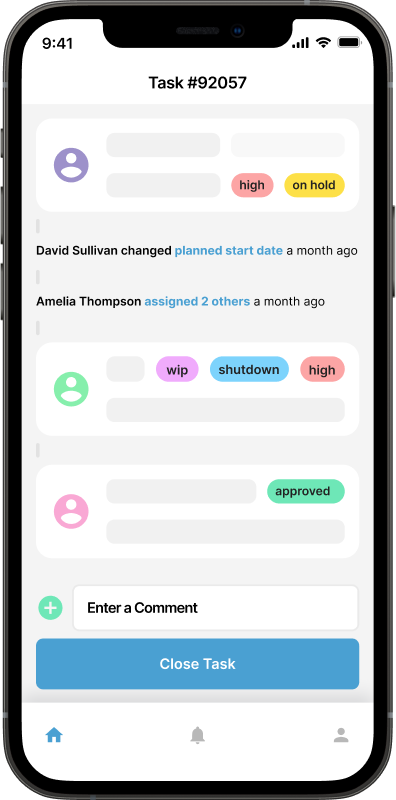Maximizing Uptime: The Role of Preventative Maintenance Software in Manufacturing
The world of manufacturing, downtime is often the enemy. It can disrupt production schedules, lead to costly repairs, and result in lost revenue. However, there is a powerful ally that manufacturing facilities can turn to in their battle against downtime - preventative maintenance software. This innovative technology, sometimes referred to as Work Order Management Software, plays a crucial role in keeping manufacturing operations running smoothly and efficiently.
In this blog, we'll explore the seven major roles of preventative maintenance software in manufacturing, shedding light on how it can help companies minimize downtime and maximize their overall productivity.
7 Major Roles of Preventive Maintenance Software in Manufacturing
To maximize uptime, preventive maintenance software plays the following key roles in manufacturing:
Role #1: Equipment Monitoring and Tracking
In today's modern manufacturing landscape, equipment monitoring and tracking have become indispensable. Preventative maintenance software is the linchpin in this crucial function. It facilitates real-time monitoring of the condition and performance of manufacturing equipment through a combination of sensors, data collection tools, and advanced analytics.
Imagine a factory floor equipped with sensors that continuously collect data on the temperature, pressure, and vibration of critical machinery. This data is then fed into the preventative maintenance software, which processes it to identify potential issues. Whether it's a slight increase in vibration, an unusual temperature spike, or a pressure drop, the software can alert maintenance teams to take action before a small problem escalates into a costly breakdown.
Role #2: Scheduled Maintenance
The heart of any preventative maintenance strategy is scheduled maintenance. Manufacturing companies can harness the power of preventative maintenance software to create and manage a structured maintenance routine. By setting up scheduled maintenance tasks, they can ensure that each piece of equipment undergoes regular inspections, lubrication, and other preventive measures.
What sets preventative maintenance software apart is its ability to send automated reminders for upcoming maintenance tasks. These reminders are tailored to the specific needs of each piece of equipment, ensuring that nothing is overlooked. This proactive approach minimizes unplanned downtime, as machinery remains in peak condition, and critical maintenance is performed on time, extending the life of costly assets.
Role #3: Inventory Management
Efficient inventory management is essential for maintaining manufacturing operations at peak efficiency. Preventative maintenance software plays a pivotal role in helping companies manage their inventory effectively. It helps keep track of spare parts, consumables, and supplies, ensuring they are readily available when needed. By setting up thresholds for inventory levels, the software can automatically trigger reorder requests, guaranteeing that essential parts are always in stock.
Effective inventory management reduces the risk of delays caused by parts shortages, minimizing the time required to source and replace critical components. This not only decreases downtime but also increases overall productivity and operational efficiency.
Role #4: Work Order Management
Work Order Management Software, often integrated with preventative maintenance software, streamlines the process of creating, assigning, and tracking work orders for maintenance tasks. It acts as the central hub for all maintenance-related activities, ensuring seamless coordination of maintenance teams.
Work orders are generated, assigned to the appropriate personnel, and tracked through the software, providing real-time updates on the status of maintenance tasks. This level of visibility and control enhances communication within maintenance teams, ultimately resulting in more efficient and organized workflows.
Role #5: Data Analysis and Reporting
In an age where data is king, preventative maintenance software excels at collecting, analyzing, and harnessing the power of data. It aggregates information from equipment sensors, maintenance activities, and historical data to provide valuable insights into equipment performance and maintenance requirements.
Manufacturers can make data-driven decisions based on the information provided by the software. It allows for the optimization of maintenance processes, the identification of trends in equipment performance, and the early detection of potential issues. Additionally, the software aids in creating detailed reports, which are invaluable for auditing, compliance purposes, and strategic planning. These reports provide a clear picture of maintenance activities, costs, and performance, facilitating informed decision-making at every level of the organization.
Role #6: Safety and Compliance
Safety and compliance are non-negotiable aspects of manufacturing, and preventative maintenance software ensures that manufacturers stay on top of these requirements. It offers a comprehensive solution for documenting maintenance activities, inspections, and equipment certifications.
By centralizing this information within the software, manufacturing facilities can maintain a high level of transparency and control. Safety protocols are consistently adhered to, and compliance with industry regulations is easier to manage. This proactive approach not only reduces the risk of accidents and workplace incidents but also safeguards manufacturers against potential legal issues.
Role #7: Cost Management
Cost management is a critical aspect of any manufacturing operation. Preventative maintenance software provides a cost-effective approach to managing maintenance activities. By preventing unplanned downtime, reducing the need for emergency repairs, and optimizing maintenance schedules, it helps companies save on operational costs.
Furthermore, the software offers complete transparency into maintenance expenses. Manufacturers can access detailed records of every maintenance task, parts, and labor cost. This information is invaluable for budget planning and cost control. By understanding where maintenance expenses are allocated, companies can make informed decisions on how to optimize their budget without compromising equipment reliability or safety.
Preventative maintenance software, often referred to as Work Order Management Software, is a vital tool in the manufacturing industry. It plays a pivotal role in maximizing uptime by monitoring equipment, scheduling maintenance, managing inventory, streamlining work orders, analyzing data, ensuring safety and compliance, and managing costs efficiently. By leveraging the power of this technology, manufacturing facilities can reduce downtime, improve productivity, and ultimately enhance their bottom line. So, if your goal is to keep your manufacturing operations running smoothly, preventative maintenance software is an indispensable asset in your arsenal. It empowers manufacturers to minimize downtime, maximize productivity, and secure their competitive edge in a fast-paced, demanding industry.

